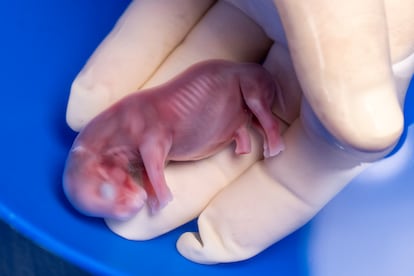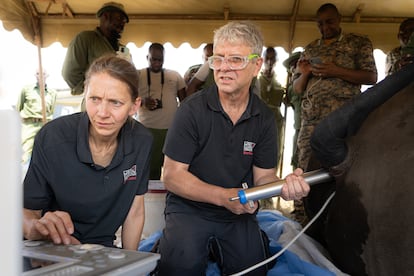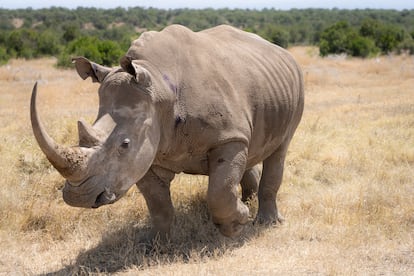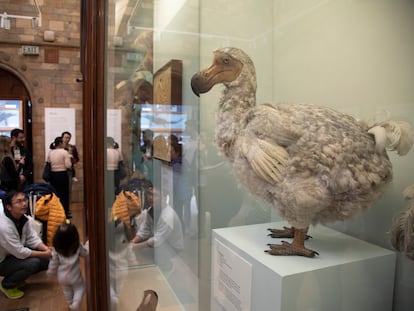With her death, Curra leaves hope that the northern white rhino can be saved from extinction
BioRescue, a German consortium, manages to implant an embryo in a surrogate mother who died from bacteria 70 days into gestation

Curra, a two-ton southern white rhinoceros, was killed by microscopic bacteria of the genus Clostridium on November 25 in Kenya’s Ol Pejeta reserve. But her death after this mismatched biological struggle was not in vain. Curra was carrying the first embryo created in a laboratory and successfully implanted by the German consortium BioRescue in her species. It is the only, risky gateway to the survival of the northern white rhinoceros subspecies, of which only two females remained: Najin and her daughter Fatu. Curra’s experience as a surrogate mother showed, for the first time, that such a scientific maneuvering is possible. Her legacy is the hope of avoiding another extinction.
Najin and Fatu, both of them descendants of Sudán, who died in 2018 from natural causes, live on in Ol Pejeta with the sad honor of being the only two survivors of the northern white rhinoceros subspecies. Their imposing presence is a shameful reminder for humanity, which is responsible for having pushed these animals into critical danger of extinction through hunting and climate change.
The BioRescue consortium, funded by the German government and formed by a dozen international entities, began a scientific program 15 years ago to produce and preserve, in liquid nitrogen at -320.8 degrees Fahrenheit, 30 embryos fertilized in laboratories in Berlin and Cremona, Italy, from the eggs and sperm of the last 12 northern white rhinos that had made it to this century alive, in reserves and zoos. All but Najin and Fatu have died. In 2019, research will begin on developing an implantation technique for surrogate mothers.
“BioRescue follows alternative scientific approaches for creating new offspring for the northern white rhinos and ensuring the highest genetic diversity of their future population… But all of these strategies converge at producing embryos in vitro and successfully transferring them into surrogate mothers to create a pregnancy,” says Susanne Holtze, project scientist.

The scarcity of northern white rhino embryos and specimens make it necessary to start out by trying with the southern subspecies, of which there are just over 10,000 animals left. And so, eggs from Elenore, who lives in the Belgian zoo Pairi Daiza, are fertilized by introcytoplasmic injection (direct to the egg) in an Italian laboratory with sperm from Athos, who lives in the Austrian zoo Hellbrunn.
It was necessary to decode the rhinos’ complex fertility cycle to determine the precise moment this transfer would take place. To figure this out, Curra lived with Ouwan, a vasectomized male who acted as stand-in. Scientists observed their mating, presumably sterile barring a vasectomy failure, on September 17 and 18, evidence that Curra was ready for insemination. BioRescue scientists and veterinarians, led by the Leibniz Institute for Zoo and Wildlife Research (Leibniz-IZW), implanted two embryos in Curra on September 24. Days later, Ouwan lost sexual interest in her: she was pregnant.
Although embryo transfer is a common technique among humans and in domestic and livestock species, it had never been achieved in rhinos. If the transfer were to work, the viability of the only path to the survival of Najin and Fatu’s lineage would be confirmed. “It has been completely uncharted territory and anything from the approach over procedure protocols to required equipment had to be invented, developed, tried and tested to be safe for use,” said Thomas Hildebrandt, head of the BioRescue-Leibniz-IZW project.
Hildebrandt clarifies that the technique his team used is very similar to that which is used for people or with cattle and horses. “But it requires a different kind of technology,” he says. “It’s not an experiment because we are not doing any harm to the animals. We only want to make calves, which is technically approved by the Kenya Forest Service, through the Kenyan government, because it is not of an experimental nature.”
The implant is not performed through the rhino’s reproductive organ, but rather its digestive tract, which is previously disinfected. A long catheter is inserted through its rectum to carry the embryo to the oviducts, where gestation begins. “The success rate is very high, even though the technique is challenging,” says the scientist.

Everything is measured down to the second and millimeter, from anesthesia to the loading of the embryo into the implantation device. “There are several very difficult and challenging elements to this procedure. However, our team is so well-trained that we are already preparing the next implant,” says Hildebrandt, who plans to perform the next implantation in May.
The white rhino requires a mating process that lasts for more than an hour and necessitates up to six ejaculations to naturally fertilize the egg, about six days after ovulation. “The female cervix is extremely long and intricate,” explains the project head. If the implant were to be performed using the uterus, it would cause irritation and damage that could impede the operation’s success. With his technique of reaching the oviducts through the rectum, the procedure is brought down to 20 minutes.
The technique worked, and Curra fulfilled her role as surrogate mother to perfection. She gestated the male embryo for 70 days, during which it grew to 2.5 inches in length. Its chance of being born alive after a gestation period between 16 and 18 months rose to 95%.
But, despite her pleasant life in Kenya and constant supervision, this time, the enemy was invisible. An adverse period of torrential flooding spread bacterial strains of Clostridium Paraclostridium bifermentans and Paenicolostridium sordelli throughout the Ol Pejeta reserve, causing a fatal infection in Curra and her companion Ouwan, who died three days before her.

Frank Göritz, head veterinarian in the project, lamented this outcome. “Witnessing the death of an animal you have worked with for so long for reasons that are beyond your control is depressing. We try to take control of every factor that affects the well-being of the animals, but in nature you cannot control everything and sometimes your plans are thwarted by heavy rains and a disease. It is very sad, but we try to look forward and to see it as a milestone for the BioRescue mission.”
Immediately following the incident, the team set up an emergency vaccination, isolation and redistribution program of the rhinos’ home range, including that of the only two existing northern white rhinos.
The next step was to analyze fetal tissue samples at Germany’s Max Delbrück Center for Molecular Medicine and Leibniz-IZW to ensure that Curra and Ouwan’s mating was sterile and that the pregnancy was in fact caused by the artificial implantation of the embryo. In January, hope for saving the northern white rhinoceros was confirmed.
The German consortium announced on Wednesday that it has already begun the next phase of the subspecies’ rescue, with the selection of a new surrogate mother, decoy male and implantation, which could take place with a northern white rhino embryo within two to three years.
The program’s director believes that the embryo and surrogate mother being different subspecies will not pose a disadvantage. A rhino with northern and southern parents was born naturally in 1978. “We are very confident that the northern white rhino embryos in our southern surrogate will be successful,” says Hildebrandt.
He adds: “We could produce between 20 and 25 northern white rhino calves in the next two to three years. Even though there are only two females left, we cannot settle for the extinction of this subspecies. We can now say that we will succeed. Success has come just in time to make this happen. We want the calves to live with Najin and Fatu for years to learn the social behavior of their species,” Hildebrandt says. A six-year grant from the German Federal Ministry of Education and Research (BMBF) ends in 2025, so a parallel race is on to secure funding for the project so that the embryo implants will be possible.
Sign up for our weekly newsletter to get more English-language news coverage from EL PAÍS USA Edition









































